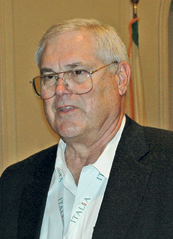Additional excerpts from Herman Wilson’s Address to Attendees at the Italian Farm Machinery Convention, Laguna Niguel, California, September 2009.
The October/November 2009 edition of Farm Equipment contained the editorial  “Telling Your Side of the Story” by Mike Lessiter. The article summarized several points made by Herman Wilson, president of the 15-store Pioneer Equipment Co. (California, Idaho and Texas) during his address at the Italian Farm Machinery Convention in September.
“Telling Your Side of the Story” by Mike Lessiter. The article summarized several points made by Herman Wilson, president of the 15-store Pioneer Equipment Co. (California, Idaho and Texas) during his address at the Italian Farm Machinery Convention in September.
In addition, Wilson covered several other topics of interest to Farm Equipment readers. Following are additional excerpts from his address that are relevant to the American farm equipment industry:
PARTS MARGINS. “The dealer is getting less than his fair share of the parts pie because of inefficiencies in distribution,” says Wilson. According to Wilson, the current margins on parts are about 30% for both the dealer and manufacturer. “The major’s 30% share was established back when the manufacturers actually manufactured something. If less than half of my orders come from the depot, why should the major get 30% of the shipment cost?” The new model he shared allows for a 40% margin for the dealer and 18% for the manufacturer.
Current Model New Model
Sale to Farmer $100 $100
Cost to Dealer $70 $60
Margin 30% $30 $40
Manuf. Depot Sale $70 $60
Cost to Manufacturer $49 $49
Margin 30% $21 $11
THE WHOLEGOODS VALUE CHAIN. In his analysis, Wilson shared numbers on the cost of wholegoods from the factory, delivery/handling, warranty/development cost and the waste in manufacturer sales costs. If manufacturers would just cut their own waste, both the dealer’s and manufacturer’s margin could rise from 10% to 20%. “The current inefficiency needs to be looked at very hard.”
Existing Proposed
Factory “out the door” cost $400 $400
Delivery & Handling $100 $100
DEALER MARGIN $100 $200
Warranty & Develop. Cost $50 $50
Manuf.’s Waste in Selling $250 $50
Total Cost $900 $800
MFR.’S MARGIN $100 $200
Sale Price $1,000 $1,000
MARKET SHARE IRRATIONALITY. “If I put a deal in front of the customer and the manufacturer decides not to come to the party price-wise, whose responsibility is it if we don’t get the order?” He also discussed market shares and how the numbers are getting jacked around. “If we have a customer that trades his tractor every 3 years or 600 hours and we go and talk him into trading every two, our market share just went up a bunch. But in the end, there’s still the same brand of tractor in that barn that still gets 600 hours of use a year.”
INVENTORY. Regardless of whether it’s the manufacturer or dealer that owns the inventory in the system, it needlessly increases capital costs. Inventory ought to be a joint effort instead of threats on what will happen if a given level of inventory isn’t ordered. Wilson says that the master distributor model — holding the manufacturers’ inventory — could cut distribution cost since aggregate inventory is better than fragmented inventories. “The master distributor would hold consigned inventory and deliver based on sales.”
FIELD REPRESENTATIVES. “When they don’t have any authority to do something, they just wasted my people’s time with each visit. In our dealership, we have more than 30 field representatives to deal with, more than 2 per store. They’ve got no technical expertise, no authority to fix problems and are only here for the order, whether it’s good for the market or not. We don’t need to order, we need to do something with what’s in the yard right now.
A DEALER’S VIEW OF THE PERFECT WORLD. Wilson’s view of utopia in the farm equipment business includes the following:
• No inventory above 10% of annual sales (10X turnover)
• High-quality product with higher margins
• Open relationship with manufacturers who value the dealer’s input
• Manufacturer representatives who respect candid conversations and who do not try to use information gleaned as damaging gossip (would not be much of a problem if field representatives were eliminated)
• Manufacturer and dealer both participating in inventory planning (dealers should have right of cancellation and manufacturers should have monthly production which reflects seasons)
• Master distributor holding manufacturer’s inventory would cut distribution cost since aggregate inventory is better than fragmented inventories





